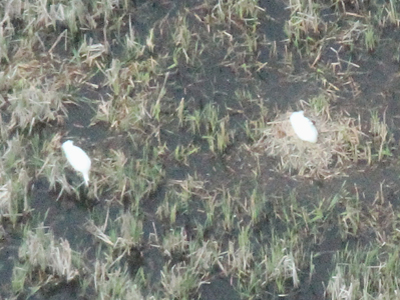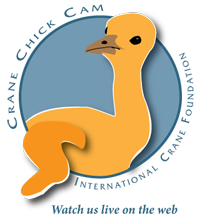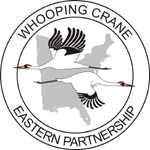| Media Contact: Joan Garland, ICF Outreach Coordinator, 608-381-1262
The Whooping Crane Eastern Partnership (WCEP) is celebrating another success in its efforts to reintroduce a wild migratory Whooping Crane population in eastern North America. A Whooping Crane chick hatched yesterday in Wood County, Wis. The chick, #W1-12 (W = wild hatched), is the offspring of Whooping Crane pair #12-02 and #19-04 from the ultralight-led crane Classes of 2002 and 2004. The pair has laid eggs every year since 2008, but until this year, their eggs have always been infertile. The pair proved to be good parents in 2010, when their infertile egg was replaced with a captive-produced Whooping Crane egg, and the pair hatched and raised the chick to fledging.  “This is an unexpected surprise, and we are happy this pair is now producing on their own. They are experienced parents and hopefully they will raise their chick to fledging age again this year,” said Dr. Barry Hartup, co-chair of the WCEP Guidance Team and International Crane Foundation veterinarian. “This also shows the great conservation value of private lands in central Wisconsin and the wonderful cooperation and interest shown by landowners in the recovery of the Whooping Crane.” Thanks to the efforts of WCEP, there are now 106 Whooping Cranes in the eastern migratory population. In addition to #12-02 and #19-04, fourteen other pairs are currently incubating, and we are optimistic that more chicks will hatch in the weeks ahead. Including #W1-12, sixteen chicks have hatched in this population since 2006. Three of them have fledged and joined the wild population. Whooping Cranes were on the verge of extinction in the 1940s. Today, there are only about 600 birds in existence, approximately 445 of them in the wild. Aside from the 106 WCEP birds, the only other migratory population of Whooping Cranes nests at Wood Buffalo National Park in northern Alberta, Canada and winters at Aransas NWR on the Texas Gulf Coast. A non-migratory flock of approximately 20 birds lives year-round in the central Florida Kissimmee region, and an additional 17 non-migratory cranes live in southern Louisiana. WCEP asks anyone who encounters a Whooping Crane in the wild to please give them the respect and distance they need. Do not approach birds on foot within 200 yards; remain in your vehicle; do not approach in a vehicle any closer than 100 yards. Also, please remain concealed and do not speak loudly enough that the birds can hear you. Finally, do not trespass on private property in an attempt to view or photograph whooping cranes. Whooping Crane Eastern Partnership founding members are the International Crane Foundation, Operation Migration, Inc., Wisconsin Department of Natural Resources, U.S. Fish and Wildlife Service, the U.S. Geological Survey’s Patuxent Wildlife Research Center and National Wildlife Health Center, the National Fish and Wildlife Foundation, the Natural Resources Foundation of Wisconsin, and the International Whooping Crane Recovery Team. Many other flyway states, provinces, private individuals and conservation groups have joined forces with and support WCEP by donating resources, funding and personnel. More than 60 percent of the project’s budget comes from private sources in the form of grants, public donations and corporate sponsors. |

|



